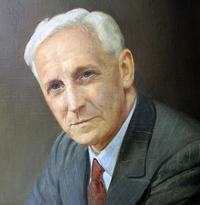Since its inception in 1912, the IBMS has championed the highest professional standards in biomedical science. Reflecting the Institute’s ethos, some 47 years after its birth, the Institute, on 17 April 1959, would be granted its own Coat of Arms, displaying the motto Disce ut Proficias – ‘Learn, That You May Improve’.
Founded as the Pathological and Bacteriological Laboratory Assistants’ Association (PBLAA), the first such organisation in the world, the Institute has grown through multiple name changes and milestones to become the leading professional body for biomedical scientists.
From humble beginnings in the early 20th century to becoming a vital pillar of modern healthcare, the Institute’s history reflects the growth and resilience of the profession and the remarkable evolution of laboratory science.
Early Beginnings: 1912–1920s

Albert Norman MBE
(1882–1964)
The Institute can trace its roots back to a meeting of the Pathological Society of Great Britain and Ireland (PathSoc) held in Liverpool on 6 January 1912, at which the PBLAA) was officially launched.
Albert Norman MBE (1882–1964), widely regarded as the founder of the PBLAA, became the Association’s first General Secretary. Norman, working in Liverpool at the time, together with a small group of other laboratory assistants – F A Izzard (Cambridge), W Manby (Manchester), R Muir (Edinburgh), J Maclean (London) – formed a provisional committee.
The initial aims of the Association were to facilitate communication, provide information about appointments, and assist in the general advancement of its members, and in practical terms to improve wages, standardise training, and gain respect in a field dominated by medically qualified pathologists.
By 1913, the PBLAA had recruited 59 members and launched its first journal, The Laboratory Journal, to share technical knowledge. World War I (1914–1918) accelerated its relevance as laboratory assistants played an important role in testing samples from soldiers suffering trench fever and dysentery.
Post-war, the Association pushed for formal education, and the first examinations were held on 5–6 July 1921, in Edinburgh, Bristol, London, Liverpool and Manchester.
Growth and Formalisation: 1920s–1940s
The 1920s witnessed steady expansion of the PBLAA, with membership nearing 200 by 1927, reflecting the growing importance of laboratory testing in the fight against tuberculosis, influenza and other public health threats.
The PBLAA, having previously introduced the opportunity for members to obtain certification on the basis of past experience, in 1929 expanded its examination syllabus by adding Pathological Chemistry to Pathological Technique, Bacteriological Technique and Museum Technique.
The 1940s brought the first change of name when, at the beginning of 1943, the PBLAA became the Institute of Medical Laboratory Technology (IMLT), a company limited by guarantee, reflecting a broader scope and a desire for scientific credibility. Later in the decade, in December 1947, the first Final examination was held in Haematology and Blood Transfusion. The 1940s also saw women entering the field in larger numbers.
World War II (1939–1945) dominated the decade and proved a turning point, as laboratory staff were crucial for wartime medicine – blood transfusions, wound infections, and penicillin development relied on their skills.
Post-war, the 1948 launch of the NHS in the UK amplified demand for trained laboratory professionals, and the Institute began to enjoy more flexibility in standardising its growing qualifications portfolio.
Modernisation: 1950s–1990s
The Institute’s global reach began in 1956, when the first IMLT Intermediate examinations were held in Nigeria. Subsequently, further examinations were held in Nigeria, Ghana, Hong Kong, Kenya, Tanzania, Uganda and Mauritius. Later, in the 1990s, the Institute would begin to accredit overseas degree programmes.
Membership had grown to 5000 by the 1960s, and the IMLT, together with the MLT Board of the Council for Professions Supplementary to Medicine (CPSM), became a gatekeeper for professional standards
The mid- to late-20th century saw an increasing shift towards specialisation and automation, with less reliance on manual methods, the introduction of automated analysers, and the slow but relentless rise in the use of molecular methods.
In 1975, the Institute changed its name once again, to the Institute of Medical Laboratory Sciences, and in 1978 the Whitley Council agreed that the designation Medical Laboratory Technician be replaced by Medical Laboratory Scientific Officer for those working in the NHS.
In late 1993, transfer to new premises was again on the agenda, and its current address, 12 Coldbath Square, became the registered office of the Institute on 1 January 1994. This date also marked a further change in name, from IMLS to Institute of Biomedical Science. It would also begin a partnership with an increasing number of new universities to offer IBMS Accredited degrees in biomedical science.
As a replacement for its Triennial Conference, the IBMS launched Congress in 1995, a biennial event that’s now Europe’s largest in the field, attracting thousands of delegates from around the world.
In navigating NHS reforms, advocating laboratory funding amid budget cuts, and solidifying its role with the CPSM’s successor, the Health Professions Council (established in 2003, and subsequently renamed the Health and Care Professions Council), the Institute, by now a degree entry profession, successfully saw its members awarded the protected title Biomedical Scientist.
Contemporary Era: 2000s–Present
To mark the Institute’s centenary in 2012, Letters of Consequence: A History of the Institute of Biomedical Science was published, written by Dr David Petts and Tony Harding.
Today, the IBMS represents over 20,000 members across 70+ countries, with a mission split between professional development, public advocacy, and policy influence. It continues to embrace the numerous advances in laboratory medicine, in particular the different branches of molecular genetics, and use of AI, emphasising its members’ vital role in diagnostics.
In 2017, the first Biomedical Science Day took place on 19 July (Albert Norman's birth date). Now celebrated in June every year across hundreds of hospitals in the UK and abroad, the event aims to raise the profile of biomedical science and to highlight the role of staff who work at the heart of healthcare.
